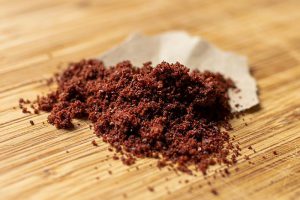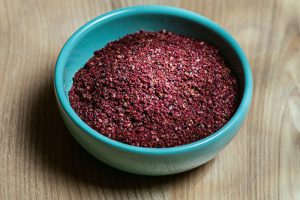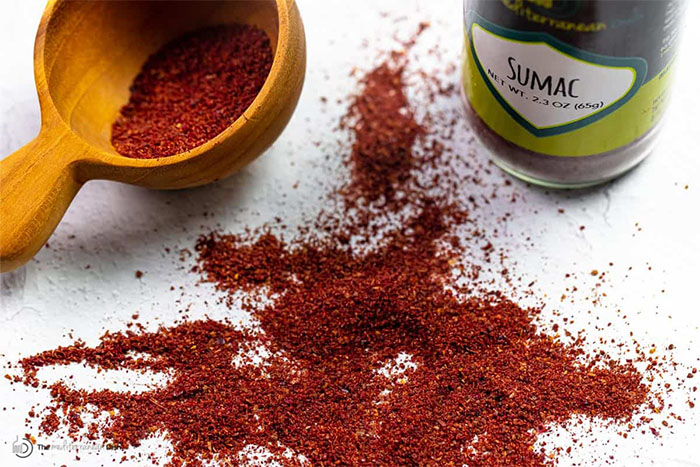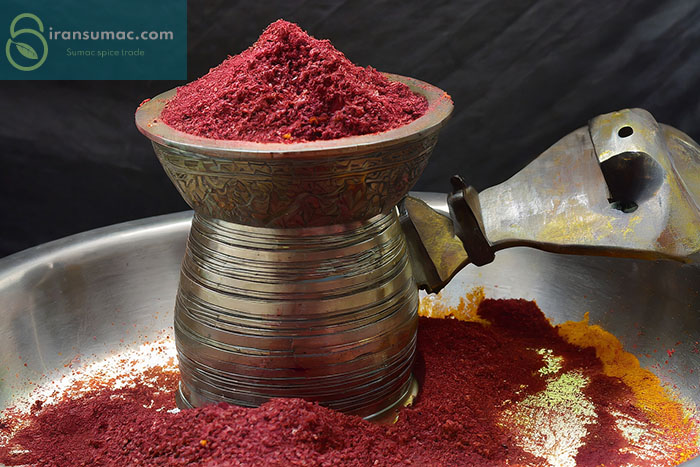Sumac export from Iran to international markets represents the highest quality of this spice. Iranian sumac is known for its tangy and lemony flavor, making it a sought-after ingredient in various cuisines. This export initiative emphasizes Iran’s commitment to delivering top-grade sumac worldwide, adhering to stringent quality standards.
What is Iranian sumac?
“Iranian Sumac Export with the Highest Quality” refers to the export of high-quality Iranian sumac to international markets. Here’s a brief explanation:
Iranian Sumac: Sumac is a spice derived from the berries of certain plants, and Iran is known for producing high-quality sumac. It is an essential ingredient in many cuisines due to its tangy and lemony flavor.
Export: This term indicates that the sumac produced in Iran is being sent to foreign countries for sale and consumption. Exporting products allows a country to share its goods with the global market.
Highest Quality: The sumac export industry in Iran has witnessed remarkable growth in recent years, driven by the increasing demand for this exceptional spice. With a strong emphasis on maintaining the highest quality standards, Iranian sumac producers have been able to establish a dominant presence in the global market.
One of the key factors contributing to the success of Iranian sumac exports is the meticulous care given to its cultivation. Sumac bushes are cultivated under optimal conditions, ensuring they receive the right amount of sunlight and nutrients. This careful cultivation process helps in producing sumac berries of the highest quality, which are then carefully harvested by skilled laborers.
This dedication to quality extends to the packaging and shipping of Iranian sumac. Special care is taken to preserve the spice’s freshness and flavor during the export process. Each package is meticulously inspected to ensure that it meets the highest standards before being shipped to destinations around the world.
Iranian sumac export plays a vital role in the country’s economy, contributing significantly to its international trade. As the reputation of Iranian sumac for its highest quality spreads globally, the demand for this exquisite spice continues to rise, making it an essential export commodity for Iran.
In conclusion, the emphasis on ‘highest quality’ in Iranian sumac export is not merely a catchphrase; it reflects a commitment to delivering a premium product to the world. The sumac industry in Iran has proven that through meticulous cultivation, harvesting, processing, and quality control, sumac can become a sought-after spice, enhancing culinary experiences on a global scale.”
Sumac in Iranian Cuisine
Iranian cuisine is a treasure trove of flavors, aromas, and culinary traditions that have been honed over centuries. Among the many spices and seasonings that contribute to the richness of Iranian dishes, export sumac stands out as a unique and versatile ingredient. This article delves into the world of sumac in Iranian cuisine, exploring its history, uses, and significance in this vibrant culinary tradition.
Historical Significance: Sumac has deep roots in Iranian culinary history, dating back to ancient times. Its use can be traced to the Persian Empire, where it was employed not only for its distinctive tartness but also for its medicinal properties. Sumac was a valuable commodity along the ancient Silk Road, traded for its flavor and purported health benefits.
Flavor Profile: Sumac is celebrated for its tangy, citrusy flavor profile. The dried berries of the sumac bush are ground into a coarse powder, which imparts a lemony zest to dishes. This unique flavor adds depth and complexity to a wide range of Iranian dishes, from kebabs and stews to salads and rice dishes.
Versatile Uses: One of the most common uses of sumac in Iranian cuisine is as a garnish for various rice dishes, including the beloved “Tahchin.” Sprinkled over the top, Sumac export not only imparts its distinctive flavor but also adds a burst of vibrant color. Sumac is also frequently used in marinades for grilled meats, such as “Joojeh kebab” (chicken kebab) and “Koobideh” (ground meat kebab).
Health Benefits: Beyond its culinary applications, sumac is believed to offer various health benefits. It is rich in antioxidants, which can help combat inflammation and oxidative stress. Additionally, sumac may aid in digestion and have antimicrobial properties.

sumac spice expiration date
You can conveniently order sumac online from the comfort of your home. Expiration dates are crucial for ensuring the freshness, flavor, and quality of spices, and they serve as a guideline for consumers to use the product within the recommended timeframe.
It is an important piece of information provided on food and spice products to ensure that consumers know when the product is at its peak freshness, flavor, and quality and to guide them in using it within the recommended timeframe to avoid any potential degradation or loss of quality. Essentially, it informs consumers about how long they can expect the sumac spice to remain in good condition for their cooking or seasoning needs.
Exporting Sumac: A Spice with a Zesty Global Appeal
Sumac, the crimson jewel of Middle Eastern and Mediterranean cuisine, has emerged as a culinary sensation worldwide, transcending borders and adding a burst of flavor to dishes across the globe. In recent years, the sumac export industry has been on a remarkable upswing, as more people discover and embrace the unique charm of this tangy spice.
The Sumac Sensation: A Global Favorite
Sumac, derived from the berries of the sumac shrub, is celebrated for its tart, lemony flavor profile, which adds a delightful twist to a wide array of dishes. Its versatility makes it a sought-after ingredient in kitchens from Beirut to Brooklyn, and beyond. Chefs and home cooks alike have recognized its potential to elevate both savory and sweet creations.
From Harvest to Export: The Sumac Journey
The journey of sumac from harvest to export is a meticulous process that ensures its exceptional quality is preserved. It all starts with the careful harvest of sumac berries from the wild or cultivated shrubs. These berries are then dried, ground, and sifted to create the fine sumac spice that graces our plates.
Global Demand on the Rise
As global palates become more adventurous, the demand for sumac continues to rise. Its distinctive tanginess makes it a desirable addition to spice blends, marinades, dressings, and more. The spice’s vibrant red hue not only enhances the visual appeal of dishes but also showcases its natural richness.
Exporting Sumac: A Growing Industry
The sumac export industry has flourished in response to the growing global appetite for unique flavors. Countries in the Middle East, where sumac has a deep cultural connection, have played a pivotal role in exporting this culinary gem. However, the trend has extended far beyond its place of origin, with sumac now available in specialty stores and international markets worldwide.
Culinary Creativity Unleashed
With sumac’s expanding availability, chefs and home cooks have been experimenting with inventive recipes. From sumac-infused roasted vegetables to sumac-spiced meats and even sumac desserts, this spice has found its way into diverse culinary creations.
Conclusion: A Tangy Revolution
In conclusion, sumac export is more than just a spice trade; it represents a culinary revolution, where global palates are embracing the zesty allure of this Middle Eastern gem. As the demand for sumac continues to soar, it promises a flavorful future filled with delightful gastronomic experiences for food enthusiasts worldwide.
From Sumac Fields to International Markets
The journey of sumac, a vibrant spice with a rich history, from its origins in the fields to international markets is a captivating tale of flavor, culture, and global appeal.
Cultivating Sumac’s Essence:
It all begins in the picturesque fields where sumac shrubs thrive under the warm sun. Expert cultivators carefully handpick the clusters of ruby-red berries that adorn these shrubs. These berries are the heart and soul of sumac, carrying the essence of its unique flavor.
The Sumac Spice Revelation:
Sumac’s popularity has transcended regional boundaries, thanks to its distinctive tartness and versatility. Its lemony zing makes it a favorite among chefs and home cooks alike, who recognize its ability to elevate a wide range of dishes.
The Art of Harvest and Processing:
After the harvest, the sumac berries undergo a meticulous drying, grinding, and sifting process to create the fine sumac spice known for its vibrant red hue. This intricate process ensures the spice’s quality and flavor are preserved.
Meeting Global Demand:
As global culinary tastes evolve, the demand for sumac has soared. Its presence in spice blends, marinades, dressings, and other culinary applications has increased significantly. Chefs worldwide treasure it for the visual and sensory impact it adds to their creations.
Sumac Export: A Growing Industry:
The sumac export industry has blossomed to meet this burgeoning demand. Countries with strong culinary traditions tied to sumac, especially those in the Middle East, have played a vital role in exporting this beloved spice. However, its global reach now extends far beyond its traditional boundaries.
Sumac’s Versatile Journey:
From Middle Eastern classics like fattoush and kebabs to international fusion cuisine, sumac has found its way into diverse culinary experiences. The spice’s journey reflects the changing landscape of modern gastronomy, where global flavors intermingle harmoniously.
Conclusion: The Global Spice Ambassador:
In conclusion, the voyage of sumac from fields to international markets is a testament to its enduring appeal. As its popularity continues to soar, it serves as a symbol of how a single spice can transcend borders, connecting cultures through the universal language of taste. Sumac is more than an export; it’s a global ambassador of flavor and tradition.

The Stages of Sumac Export
The journey of sumac from its source to global markets involves several distinct stages, each contributing to the spice’s worldwide appeal and culinary significance.
- Cultivation and Harvest:
The first stage in the sumac export process is cultivation and harvest. Sumac is primarily grown in regions with a warm, Mediterranean climate, where the shrubs thrive under the sun’s rays. Skilled farmers carefully handpick the bright red clusters of berries from the sumac shrubs during the peak harvest season. These berries serve as the raw material for the sumac spice.
- Drying and Processing:
After harvesting, the sumac berries undergo a meticulous drying and processing phase. The berries are laid out to dry in the sun or carefully dried using modern techniques to preserve their flavor and quality. Once dried, they are ground into a fine powder, often sifted to ensure consistency, and packaged for distribution.
- Quality Control:
Quality control is a crucial stage in the sumac export process. Sumac producers employ rigorous quality control measures to ensure that the final product meets the highest standards. This includes testing for flavor, color, aroma, and overall quality to guarantee a consistent and premium product.
- Packaging and Labeling:
Once the sumac is ground and processed, it is carefully packaged and labeled for distribution. Packaging may vary, ranging from small containers for retail sale to larger quantities for the food industry. Labels often include essential information such as origin, quality, and usage instructions.
- Distribution and Export:
The distribution and export phase is where sumac begins its journey to international markets. Producers work with distributors and exporters to reach a global audience. Sumac’s export network has expanded significantly in recent years, making it accessible to chefs, restaurants, and consumers worldwide.
- Culinary Exploration:
Once sumac reaches its destination, it finds its way into the hands of chefs and culinary enthusiasts. Its tangy and lemony flavor profile makes it a versatile ingredient in various cuisines. Chefs experiment with sumac to create unique recipes, from spice blends to marinades, dressings, and more.
- Global Culinary Impact:
Sumac’s journey culminates in its global culinary impact. Its distinctive flavor and vibrant red hue have made it a favorite in kitchens around the world. It enhances both the visual appeal and taste of dishes, contributing to the globalization of culinary traditions.
In conclusion, the stages of sumac export reflect the spice’s journey from cultivation to international prominence. Sumac’s unique flavor and versatility have propelled it onto the global culinary stage, enriching dishes and captivating taste buds worldwide.




